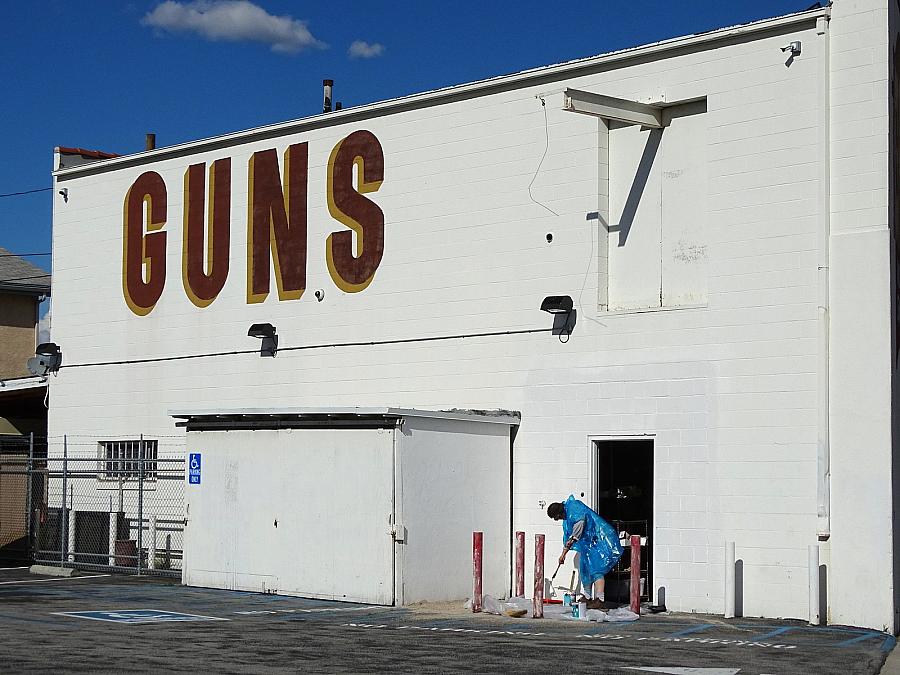Is panic-fueled gun buying leading to a rise in deaths and injuries in California?

A Culver City gun store in 2019.
Before the COVID-19 pandemic, certain events were known to trigger spikes in gun purchases: hurricanes, mass shootings, changes in gun laws, 9/11, and the election of President Obama.
Fast forward to 2020, which saw upticks in California gun sales around the time of the first COVID-19 stay-at-home order and when demonstrations in support of Black Lives Matter erupted across the country.
According to a survey conducted by the University of California Firearm Violence Research Center, in California “an estimated 110,000 individuals acquired a firearm in response to the pandemic, including 47,000 new owners.” The survey was taken during the last two weeks in July 2020.
My 2020 Data Fellowship project will investigate whether panic gun buying is related to an increase in accidental injuries, homicides, or suicides in California since the state’s shelter-in-place order went into effect in 2020.
After the Isla Vista mass murder and suicide in 2014, gun violence prevention and gun policy have become an ongoing theme in my reporting. I covered the events alongside my journalism students the night of the murders, and in the aftermath produced programs that showcased their work. In 2015, I wrote a story for The Guardian on the implementation of California’s new Gun Violence Restraining Order. In 2016, I produced a documentary that looked at one UC Santa Barbara student, a survivor of the Isla Vista killings, who developed a workshop series on the connections between toxic masculinity and mass shootings among young men. Then in 2019, I was awarded a USC Annenberg Center for Health Journalism California Fellowship to produce a documentary that examined the potential effects of the state’s Gun Violence Restraining Order in preventing injury and death in intimate partner relationships.
While reporting for my 2019 fellowship project, I knew there were data sets that could have better informed the story. My 2020 fellowship project will be able to benefit from data-informed reporting.
In 2008, gun sales surged over fears that a Democratic Congress and presidency would result in a tightening of rules on gun access and ownership. Some said they feared a race war. One 2015 study in the Journal of Public Economics found that states with the biggest demand for guns after the election of Obama “were 20% more likely to experience a shooting event where at least three people were killed.” This instance of panic gun buying permanently changed the number of firearms that remained in circulation within those same high-demand states. The same could hold true for California after this year’s uptick in sales and first-time gun owners.
My data project will also examine whether first-time gun owners are seeking out additional firearms training.
All new gun owners in California are required to test for their Firearm Safety Certificate, which demonstrates the most basic understanding of safe handling and storage. If the California driver’s license qualification test were administered in the same way as a California FSC test, it might look like this: A prospective driver walks into a car dealership, takes a multiple-choice test administered by one of their salespeople. The applicant then demonstrates that they know how to turn on the ignition, work the knobs, make a left turn, and step on the brake pedal all while sitting in a parked car. No actual driving on the road would be required.
Similarly, during a Firearms Safety Certificate test, the applicant does not have to demonstrate that they can actually load live ammunition into a gun and fire it safely.
Whether new California gun owners are seeking out more extensive training on how to fire, handle, and store their weapon is unclear. The data will help me to get a clearer picture of this group. It will also show whether there has been an increase in gun-related injury and death since the state’s shelter-in-place order went into effect in 2020.

